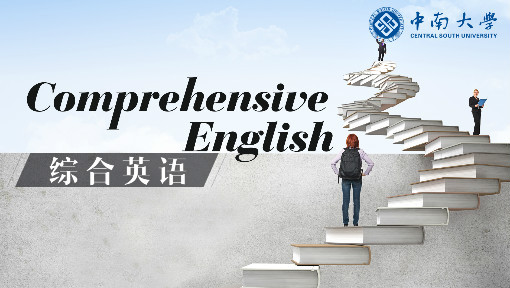
当前课程知识点:University Physics - Electricity and Magnetism > Chapter III Magnetic Fields > Lecture 32 Magnetic Materials > Lecture 32 Magnetic Materials
返回《University Physics - Electricity and Magnetism》慕课在线视频课程列表
返回《University Physics - Electricity and Magnetism》慕课在线视频列表
这一讲,我们研究磁介质。
我们讨论的第一类磁介质称为顺磁质。顺磁质内部,原子存在固有磁矩。
在顺磁质内,固有磁矩相互作用较弱,磁效应较弱。
没有加磁场的时候,各个固有磁矩取向杂乱无章。施加外磁场后,磁矩趋于于外场同向排列。
例如,我们将顺磁质放入外场B0,正如之前讨论的,由于力矩的作用,磁矩取向趋于与外场平行,产生磁化。磁化强度为M。
请注意M平行于B0,所以介质内的磁场被增强。总磁场等于两个磁场的矢量和,这里的Bm是由固有磁矩的磁化产生的附加磁场,等于μ0乘以M。
现在我们比较一下电介质和顺磁质在外场中的区别。
在两种情形下,电偶极矩和磁偶极矩都会在力矩的作用下发生转动,取向都趋于与外场平行。
但是,顺磁质被磁化的结果,是增强了磁场,然而,电介质被极化的结果,是削弱了电场。
实验发现,磁化强度M与外磁场B0成正比,为线性关系。
此式给出了M和B0之间的关系。其中,χm 称为磁化率,是一个无量纲的量。
代换M后,介质内的磁场B可以写成此式。其中,κm等于1加上χm, 称为磁介质的相对磁导率。
对于顺磁质,χm大于零,κm大于1.磁介质的磁导率可以定义为:μm等于相对磁导率κm乘以μ0。
显然,顺磁质的磁导率μm大于真空磁导率μ0。
第二类磁介质是抗磁质。在抗磁质内部,分子的固有磁矩为零。。
当加上外磁场后,磁介质被磁化,产生磁矩。但产生的磁矩方向与外场相反。
于是,磁化强度M和附加磁场Bm与外磁场B0反向,导致介质内的磁场减小。这个效应与电介质削弱电场的效应相似。
在抗磁质中,κm 小于 1, 因此磁导率μm 小于真空磁导率 μ0.
这里需要注意的是,抗磁性存在于所有物质,但是抗磁性相比于顺磁性和铁磁性非常弱。只有当其它磁效应不存在的时候,才显示出抗磁性。
这是一个完全抗磁的例子。超导体进入超导状态,显示出抗磁性。
由于外加磁场的场线无法进入超导体内部,导致内部磁场非常弱或为零。这个现象称为迈斯纳效应。
请看这幅图,由于这个效应,小磁铁悬浮于超导体上方。
现在我们再来看第三类磁介质——铁磁质。与顺磁质和抗磁质相比,由于相邻原子磁矩之间的强相互作用,铁磁质具有非常强的磁效应。
典型的铁磁质包括铁,钴,镍等。
由于相邻原子磁矩的相互作用非常强烈,使得铁磁质内部的磁矩有序化程度比顺磁质高得多。
一旦磁矩有序化,即使外场撤除,介质仍然保留磁化。让我们来仔细探讨一下铁磁质的磁效应。
如图所示,所有铁磁质都是由一些微小的区域——磁畴构成。这些区域内,所有磁矩都是有序化的。
请看这幅图。当介质放置在外磁场B0中,磁畴的尺寸变大,直至所有磁畴的磁矩都沿外场方向排列。
当外场撤除后,介质仍能保留与原来外场同向的净磁化强度。
因此,铁磁质可以显著地增大磁场。磁铁内部的总磁场数量级可以比外加磁场大10的三次方或四次方这样的数量级。
铁磁质的相对磁导率κm不是常数。总磁场B或磁化强度M与B0也没有线性关系。磁化强度M和外磁场B0的关系取决于磁介质之前的磁化情况。
这种现象称为磁滞。这幅图描绘了磁化强度M随外磁场B0变化的函数关系。回路abcdef称为磁滞回线。
在铁磁质中,磁矩之间的强相互作用可以让它们保持有序化,即使外加磁场为零,如图所示。
于是,即使没有外场,这些取向排列一致的磁矩也会产生较强的磁场,这正是永久磁铁的根源所在。
在普通温度下,磁矩同向排列不会因为热运动而被破坏。
但是,当温度达到或超过某一临界温度,我们称为居里温度,那么磁介质就会失去剩磁。
在居里温度以上,热运动非常强烈,导致磁矩的取向变得杂乱无章,结果,铁磁质变为顺磁质。
至此,我们已经讲了很多关于磁的故事。从下一讲开始,我们进入一个新的话题——电磁感应。
-Lecture 1 Electric Charges
-Lecture 1 Electric Charges--作业
-Lecture 2 Coulomb’s Law
-Lecture 2 Coulomb’s Law--作业
-Lecture 3 Electric Fields
-Lecture 3 Electric Fields--作业
-Lecture 4 Evaluation of Electric Fields(I)
--Lecture 4 Evaluation of Electric Fields(I)
-Lecture 4 Evaluation of Electric Fields(I)--作业
-Lecture 5 Evaluation of Electric Field (II)
--Lecture 5 Evaluation of Electric Field (II)
-Lecture 5 Evaluation of Electric Field (II)--作业
-Lecture 6 Electric Field Lines
--Lecture 6 Electric Field Lines
-Lecture 6 Electric Field Lines--作业
-Lecture 7 Electric Flux
-Lecture 7 Electric Flux--作业
-Lecture 8 Gauss’s Law
-Lecture 8 Gauss’s Law--作业
-Lecture 9 Application of Gauss’s Law
--Lecture 9 Application of Gauss’s Law
-Lecture 9 Application of Gauss’s Law--作业
-Lecture 10 Electric Potential
--Lecture 10 Electric Potential
-Lecture 10 Electric Potential--作业
-Lecture 11 Evaluation of Electric Potential
--Lecture 11 Evaluation of Electric Potential
-Lecture 11 Evaluation of Electric Potential--作业
-Lecture 12 Finding E from V
-Lecture 12 Finding E from V--作业
-Lecture 13 Properties of a conductor in electrostatic equilibrium (I)
--Lecture 13 Properties of a conductor in electrostatic equilibrium
-Lecture 13 Properties of a conductor in electrostatic equilibrium (I)--作业
-Lecture 14 Properties of a conductor in electrostatic equilibrium (II)
--Lecture 14 Properties of a conductor in electrostatic equilibrium (II)
-Lecture 14 Properties of a conductor in electrostatic equilibrium (II)--作业
-Lecture 15 Dielectrics
-Lecture 15 Dielectrics--作业
-Lecture 16 Capacitor & Capacitance
--Lecture 16 Capacitor & Capacitance
-Lecture 16 Capacitor & Capacitance--作业
-Lecture 17 Capacitors with dielectrics
--Lecture 17 Capacitors with dielectrics
-Lecture 17 Capacitors with dielectrics--作业
-Lecture 18 Energy stored in a capacitor
--Lecture 18 Energy stored in a capacitor
-Lecture 18 Energy stored in a capacitor--作业
-Lecture 19 Magnetism
-Lecture 20 Current & Current Density
--Lecture 20 Current & Current Density
-Lecture 20 Current & Current Density--作业
-Lecture 21 Steady current & Electromotive force
--Lecture 21 Steady current & Electromotive force
-Lecture 22 Magnetic Fields
-Lecture 22 Magnetic Fields--作业
-Lecture 23 Charged Particle in a Magnetic Field
--Lecture 23 Charged Particle in a Magnetic Field
-Lecture 23 Charged Particle in a Magnetic Field--作业
-Lecture 24 Magnetic Force on a Current—Carrying Conductor
--Lecture 24 Magnetic Force on a Current—Carrying Conductor
-Lecture 24 Magnetic Force on a Current—Carrying Conductor--作业
-Lecture 25 Sources of a Magnetic Field
--Lecture 25 Sources of a Magnetic Field
-Lecture 25 Sources of a Magnetic Field--作业
-Lecture 26 Calculation of a magnetic field by applying the Biot-Savart Law
--Lecture 26 Calculation of a magnetic field by applying the Biot-Savart Law
-Lecture 26 Calculation of a magnetic field by applying the Biot-Savart Law--作业
-Lecture 27 Ampere’s Law
-Lecture 27 Ampere’s Law--作业
-Lecture 28 Application of Ampere’s Law
--Lecture 28 Application of Ampere’s Law
-Lecture 28 Application of Ampere’s Law--作业
-Lecture 29 Gauss’s Law in Magnetism
--Lecture 29 Gauss’s Law in Magnetism
-Lecture 29 Gauss’s Law in Magnetism--作业
-Lecture 30 Origin of the magnetic effect of materials
--Lecture 30 Origin of the magnetic effect of materials
-Lecture 30 Origin of the magnetic effect of materials--作业
-Lecture 31 Magnetization
-Lecture 31 Magnetization--作业
-Lecture 32 Magnetic Materials
--Lecture 32 Magnetic Materials
-Lecture 32 Magnetic Materials--作业
-Lecture 33 Faraday’s Law
-Lecture 33 Faraday’s Law--作业
-Lecture 34 Motional EMF
-Lecture 34 Motional EMF--作业
-Lecture 35 Induced Electric Field
--Lecture 35 Induced Electric Field
-Lecture 35 Induced Electric Field--作业
-Lecture 36 Generators
-Lecture 36 Generators--作业
-Lecture 37 Inductance
-Lecture 37 Inductance--作业
-Lecture 38 Energy in a Magnetic Field
--Lecture 38 Energy in a Magnetic Field
-Lecture 38 Energy in a Magnetic Field--作业
-Lecture 39 Maxwell’s Equations
--Lecture 39 Maxwell’s Equations
-Lecture 39 Maxwell’s Equations--作业


